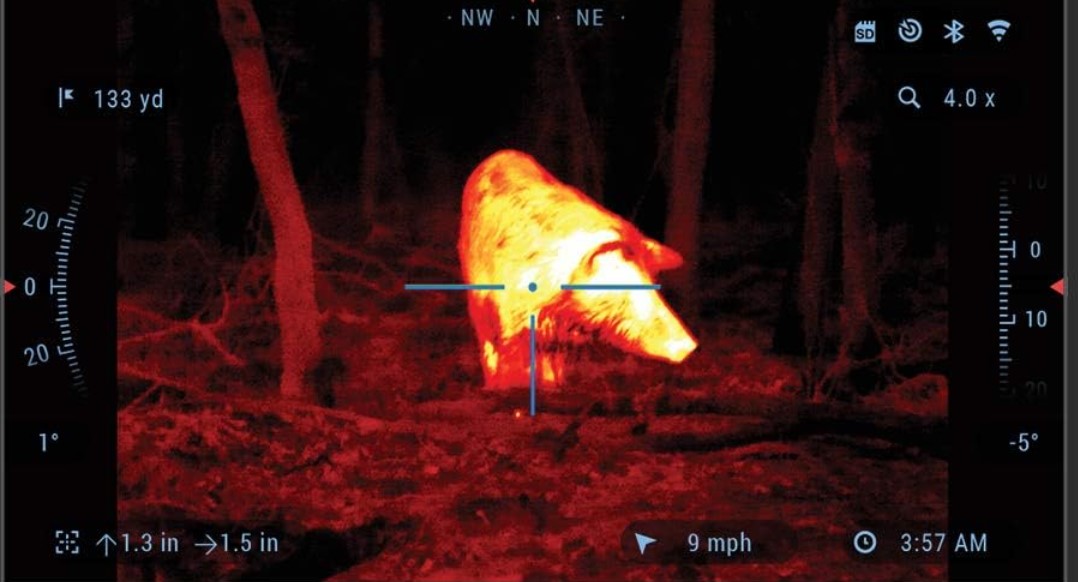Are you a hunter, in security surveillance, or require the best thermal rifle scope to tackle pests, with poise and accuracy? Well, this is the article that goes through some of the options you can bank on
Here we compare the top thermal scopes on the market based on a variety of criteria, including capabilities and features, as well as honest reviews from the users.
The options provided vary in price, but each is a class leader in its price range and offers excellent value for money.
Without further ado, let us begin.
| Summary | |
Trijicon REAP Thermal Rifle Scope
|
|
Pulsar Thermion 2 LRF xp50
|
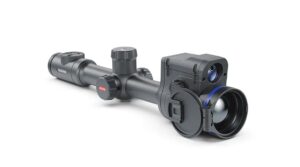 |
ATN Thor 5 LRF
|
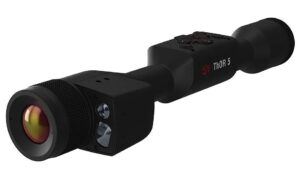 |
AGM Global Vision RattlerV2
|
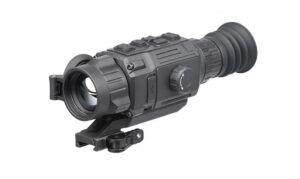 |
SightMark Wraith
|
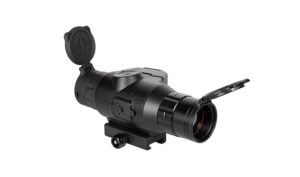 |
Detailed reviews…
1) Trijicon REAP Thermal Rifle Scope
![]()
This purpose-built thermal rifle scope stands out for being small, and lightweight. Still, despite its size, it’s effective and reliable. It offers advanced thermal imaging technology for superior performance in various shooting scenarios.
To produce exceptionally bright images, it employs a 640 x 480-pixel sensor with a 12-micron pixel pitch. This compact but advanced sensor reduces the scope’s size and weight without sacrificing performance or durability; a 60 Hz refresh rate is also useful when shooting at moving objects.
The REAP-IR Type 3 also has an impressive battery life, allowing for longer periods of operation without the need for regular recharges. It’s simple to mount, includes video recording capabilities, and provides shooters with a variety of reticle options.
Specifications
- 1.75x Magnification
- 640x 480 thermal sensor 60 Hz
- 12-micron pixel pitch
- USB-C port
- Video recording capabilities
- Meets MIL-STD-810G standards
Pros
- Small and Lightweight
- Exemplary images
- It’s easy to fix on a rifle
- Features a rugged multi-directional thumb stick control
- Video recording capabilities
Cons
- Pricey
2) Pulsar Thermion 2 LRF xp50 Pro Thermal Scope

If you so desire a variable magnification, then with this thermal scope you get 2-16x of versatile magnification that still delivers a clear image all through the magnification range. Additionally, it’s loaded with a variety of convenient features such as the picture in picture mode, which enables the shooter to display a high-precision zeroing frame. Taking only 10% of the total display area.
Another great feature is the 5 shooting profiles available for a variety of weapons, and each profile can hold up to 10 zeroing distances. Moreover, an included rangefinder is good for 875 yards
The scope’s sensor measures 640×480 pixels with a 17-micron pixel pitch. It produces bright visuals that are further improved by the 9-color palette to work with the 10-reticle designs offered.
Specification
- 2-16x magnification
- 640x 480-pixel 50Hz refresh rate
- 1024×768 AMOLED Display
- 16GB internal memory
- Wi-fi connectivity
- Mounts on Standard 30 Mm Rings
- IPX7 waterproof rating
Pros
- Detects heat signatures up to 2,000 yards away
- Built to withstand big calibers such as the 12-gauge
- Includes a rangefinder
- 5 Unique shooting profiles
- Video recording.
Cons
- None
3) ATN Thor 5 LRF Thermal Scope

ATN has established a reputation for night vision and thermal optics, and the Thor 5 with a varied magnification range of 3-24X continues to demonstrate why it is the best. This high magnification enables you to zoom in on targets from 1200 yards. A rangefinder provides accuracy of up to 275 yards.
In addition to its impressive imaging capabilities, the ATN Thor 5 LRF Thermal Scope is designed with user convenience in mind. Even under duress, navigating and adjusting settings is made simple by the user-friendly interface and straightforward controls.
A powerful sensor with a resolution of 640 x 480 and 12 microns produces bright, sharp images even in total darkness or through haze and vegetation, making targets easy to identify. The refresh rate of the thermogram is 60Hz.
Other features include a recoil-activated video recording feature, a ballistic calculator, the ability to design custom reticles, and video streaming.
Specification
- 3-24x magnification
- 640 x 480-pixel sensor resolution
- 60 Hz refresh rate
- 275 yards laser rangefinder
- 5th gen Quad Core processor
Pros
- Recoil-activated video recording
- Easy to use
- Decent 10-hour battery life
- 90mm eye relief
- Custom reticle feature
Cons
- None
4) AGM Global Vision RattlerV2 35-384

An upgraded model of the AGM Rattler series of thermal scopes has a 384×288 thermal resolution and a 3x base magnification. The scope has enhanced capabilities, such as improved target identification, a smoother interface, an upgraded body design, and a detection range of 1,800 yards. Through its 35mm lens, one can identify targets in some of the most challenging conditions such as fog, smoke, or dense vegetation.
Additionally, you get a decent battery capable of lasting for 11 hours, and a new 12-micron thermal sensor that has the highest sensitivity rating (sub-20 mk) on the market.
Other features include Wi-Fi hotspot connectivity via the AGM app, ten reticle options with multiple zeroing profiles for different calibers and rifles, a custom ADM QD Mount for easy removal and reattachment, shot-activated recording, and an intuitive 5-button layout that is elevated for easy navigation—even while wearing gloves.
Specifications
- 3-24x magnification
- 384 x 288 pixels sensor
- 35mm Germanium lens
- 1800 m/yd Detection range
- 50 Hz refresh rate
- 10 different reticle options
- Enhanced focus ring with short throw
Pros
- Simplified Menu
- Long battery life
- 16 GB internal storage
- Priced well
Cons
- Slightly bulky at 0.5Kg
5) SightMark Wraith SM17001 Thermal Scope

If you want an affordable thermal scope with decent features then this one is the best choice out there on the market. It’s 384×288 pixel sensor although slightly smaller than higher-priced scopes it’s very capable and will give you a clear picture in bad weather conditions.
The Thermal scope is made to be rugged, but where it falls is the battery life which only manages 3.5 hours. It manages a detection range of 1,400 yards but practical engagement capabilities are 250-300 yards. Users benefit from its user-friendly interface, including five firearm profiles, multiple reticle and color options, and video recording capabilities.
Specifications
- 384×288 resolution thermal sensor
- 1-8x digital zoom
- 1400 yards detection range
- 5 Color Palettes
- 10 reticles
- Weighs 19.3 Oz.
Pros
- Budget-friendly price
- Rugged construction
- User-friendly interface
- Different reticle colors
Cons
- Rather short battery life
How Thermal Scopes Work
A thermal scope detects infrared radiation (heat) released by surrounding objects and converts it into a visible thermogram image that can be seen through the scope. This is simple to do because the temperature difference between different objects is constantly there. As an illustration; consider a block of ice put next to a piece of wood; the ice will emit a lower temperature than the wood, and these different temperatures will be represented on the thermal scope in distinct hues, resulting in defined images of both the wood and the block of ice.
Advantages of Thermal Over Night Vision
Although used for similar functions with night vision scopes, thermal scopes carry several advantages which include;
1. Works in complete darkness
While night vision requires ambient lighting, thermal works even in ominous darkness, because it doesn’t rely on light.
2. Can see through obstructions.
Heat can be dissipated through obstructions such as vegetation and the capability of these scopes in such environments makes them very useful for hunting.
3. Longer Detection Range
Unless with the use of a magnifier and optical zoom, night vision depends on the capability of the eyes. The detection range on a thermal scope, conversely, will depend on the size of the thermal sensor present.
Factors to Consider When Choosing a Thermal Scope
When choosing a thermal scope, several key factors should be considered to ensure you end up with the best device.
Sensor resolution
Sensors with higher resolution are more sensitive to heat signatures and provide images with better detail, which is crucial for identifying targets at various distances. Look for a thermal scope with a minimum resolution of 384×288 pixels
Detection Range
This is how far the scope can detect heat signatures. Depending on the intended use, it’s definite that you have a minimum detection range in mind. If the thermal scope is for hunting, for example, a longer detection range would be more beneficial.
Magnification
Thermal scopes offer both optical and digital magnification. Digital magnification is mostly used to identify a target, but optical magnification can be used to perfect the aim.
Battery Life
Something to consider if you spend extended time out in the woods. A great battery gives you better durability to achieve your goals. A shorter battery life can however be sorted with the use of external power options.
Refresh Rate
This is how fast the display regenerates itself per second. The higher this rating (Measured in Hz) the smoother the images will be. Higher refresh rates are also greatly useful when tracking targets.
Price
A thermal scope with great features will be available at a higher price. Consider your needs and the cost you are willing to pay, and also what features you can forego.
Best Thermal Scopes for 2024-FAQs
Can thermal scopes be used in daylight?
Yes, thermal scopes can be used during the day and night. This Is because they detect heat rather than relying on ambient light, making them effective in any lighting condition.
Are thermal scopes legal to use?
The legality of thermal scopes depends on the jurisdiction they are being used. In many places, however, restriction is only on specific use but generally legal.
How much do thermal scopes cost?
Thermal scopes typically cost between several hundred and several thousand dollars, depending on the features, resolution, detection range, and brand.
How durable are thermal scopes?
The thermal scope is often a fairly durable equipment. Durability is a deliberate effort by the manufacturer because most are supposed to be employed in adverse conditions.
Conclusion
I appreciate that you have gone through this article, up to this point, and are now familiar with the best thermal rifle scope. Now it’s up to you to decide from the list, the best one that suits you depending on the features, and your budget. The Pulsar Thermion 2 LRF xp50 and the Trijicon REAP however stand out for their great capabilities and range. If you are on a budget, you can opt for the sight mark Wraith SM17001
Related
